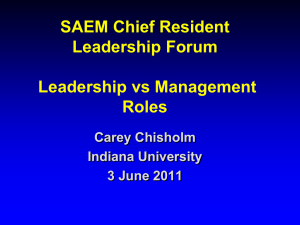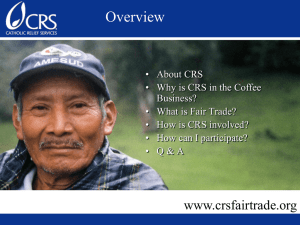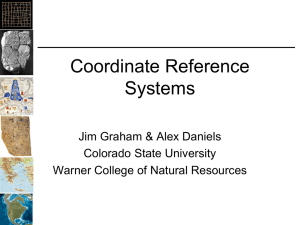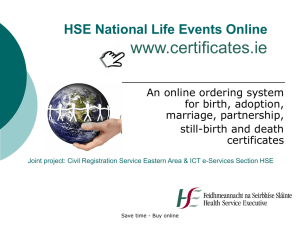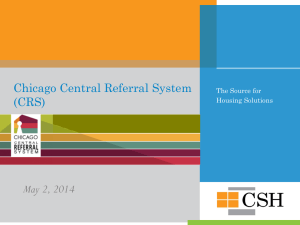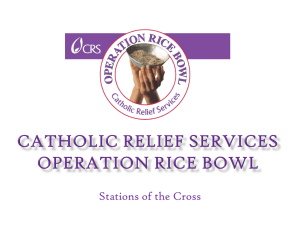and chronic rhinosinusitis (CRS)
advertisement
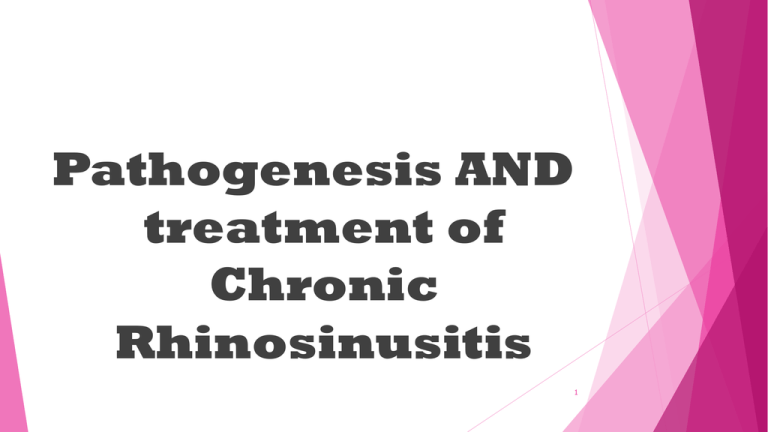
Pathogenesis AND treatment of Chronic Rhinosinusitis 1 OVERVIEW: Acute rhinosinusitis (ARS) and chronic rhinosinusitis (CRS) are defined as symptomatic inflammation of the nose and paranasal sinuses with the distinction between the two based on the duration of the complaints. Although ARS is widely considered to be an infectious disorder. CRS, on the other hand, is typically described more broadly as an inflammatory disorder, and the importance of specific microbial agents in driving the process remains controversial. 2 Pathogenesis of CRS CRS is primarily idiopathic; however, small numbers of patients have an established association with systemic immunologic or genetic diseases. Broad theories on the etiology and pathogenesis of CRS have been proposed that place particular emphasis on either specific microbial agents or host defects Pathogenesis of CRS Viruses, fungi, bacteria, allergens, and other foreign materials interface with the Sinonasal epithelium. In patients with CRS, this interaction results in persistent mucosal inflammation and the Secondary symptom complex associated with the disorder. The microbial agent most commonly associated with CRS is Staphylococcus aureus Pathogenesis of CRS The staphylococcal superantigen hypothesis is the most widely established microbial hypothesis of CRS pathogenesis. The central tenet proposes that S. aureus sequestered within epithelial cells or in a biofilm format secretes exotoxins, which results in multiple effects that foster eosinophilic polyp formation Pathogenesis of CRS The host response to exogenous stimulation begins with epithelial cell activation that leads to the secretion of cytokines and chemokines that are important not only in triggering the innate immune response but also in shaping the appropriate adaptive immune response. Defects anywhere along these complex indicating pathways may predispose to the development of CRS Pathogenesis of CRS The immune barrier hypothesis is the most widely accepted host-centered hypothesis and proposes that local defects in the mechanical and innate immune barrier result in increased microbial colonization and increased inflammatory stimulation of the sinonasal mucosa. A compensatory adaptive immune response is then initiated. … At present, factors that have been associated with the etiology and pathogenesis of CRS include : fungi, resistant bacteria, superantigens, biofilms, atopy, mucociliary dysfunction, environmental irritants, acquired sinonasal obstruction (especially of the ostiomeatal complex), osteitis, and genetic or epigenetic variation of the host. 8 Overall concept of CRS Overall, this leads to the concept that CRS pathogenesis is best described as a dysfunctional interaction that occurs at the site of interface between the host and the environment: the sinonasal mucosa (Fig. 45-1). 9 10 The immune barrier hypothesis The immune barrier hypothesis proposes that defects in the mechanical barrier and/or the innate immune response of the sinonasal epithelium manifests as CRS.7 Increased microbial colonization and accentuated barrier damage lead to increased stimulation of the immune system with a compensatory adaptive immune response (Fig. 45-2). 11 12 mucosal immunity of the respiratory tract rather or the systemic immune system problem … In other words, a dysfunctional immune response to exogenous factors at the sinonasal mucosal border leads to the mucosal inflammation, radiographic changes, and symptoms that characterize CRS. Interestingly, epidemiologic studies on idiopathic CRS patients have demonstrated a strong association with asthma but only a weak, if any, association with other chronic inflammatory disorders. This suggests that the key host factors associated with CRS development are likely specific to the mucosal immunity of the respiratory tract rather than the systemic immune system. 13 biofilm hypothesis The biofilm hypothesis suggests that biofilms, in particular staphylococcal biofilms, can serve as etiologic agents that cause CRS. It can be speculated that a defect in the immune barrier might facilitate formation of biofilms, which would suggest a role in pathogenesis rather than etiology. 14 CONCLUSIONS: Delineation of the etiology and pathogenesis of CRS remains a work in progress, and the current hypotheses vary in terms of points of emphasis, scope, and supportive evidence. Each may very well describe parts of this complex syndrome. Moreover, the hypotheses are less in conflict than they might appear. Inherent immune and barrier defects should predispose to the establishment of biofilms as well as to stimulation by fungi and bacteria. Both fungi and bacteria have substantial intrinsic protease activities, which may degrade tight junctions and accentuate host barrier compromise.The presence of intracellular S. aureus in epithelial cells from CRSwNP, but not CRSsNP or controls, supports the concept of defective local immune and/or barrier function.. 15 Treatment options in CRS Antibiotics Duration(Short course or Long course) Oral ,iv,local Antifungal Medications Oral ,iv,local CORTICOSTEROIDS TOPICAL systemic ANTIHISTAMINES LEUKOTRIENE ANTAGONISTS SALINE IRRIGATIONS Antibiotics — Mucosal colonization with Staphylococcus aureus has been found in 64 percent of patients with CRS and NP, compared with roughly 30 percent in healthy individuals or patients with CRS. In addition, immunoglobulin E (IgE) antibodies directed against Staphylococcal superantigens have been found in the tissues of a high percentage of colonized polyposis patients. Based on these observations, a randomized, double-blind, placebo-controlled trial was conducted to assess whether doxycycline could reduce nasal polyp size and provide antiinflammatory effects [80]. Doxycycline (200 mg on the first day followed by 100 mg once daily for 20 days) caused a small but statistically significant reduction in polyp size beginning at week 2 and persisting for 12 weeks. A significant reduction in nasal secretion eosinophil cationic protein (ECP) was also found after 20 days of doxycycline treatment. However, doxycycline caused no statistically significant improvement in nasal peak inspiratory flow rate. MEDICAL TREATMENTS : : ANTIBIOTICS Microbial pathogens have always been considered a fundamental component of the overall pathophysiology of CRS. The concept of CRS as a persistent or perhaps recurrent infection dominated early thinking and was reinforced by the high prevalence of pathogenic bacteria in sinonasal cultures. Although the inflammatory nature of CRS is emphasized today, bacteria certainly may play a role in disease exacerbations and may to some degree promote the chronic mucosal inflammation that characterizes the disease. :Antibacterial Medications :Oral Medications Oral antibiotics for CRS can be broken down into macrolide and nonmacrolide classes. Although the macrolide class of antibiotics also has antibacterial effects, these medications have known anti inflammatory properties, which have been documented both in the upper and lower airways of patients with CRS, asthma, and cystic fibrosis. The nonmacrolide antibiotics would include commonly utilized agents such as penicillins, cephalosporins, and fluoroquinolones among others, all of which are theorized to work via their antibacterial effects. DURATION evidence-based reviews have classified short-term oral antibiotics as regimens of less than 3 to 4 weeks in duration and long-term oral antibiotics as those with a duration of 3 months or more. Thus, routine use of extended courses of short-term(6-8 WEEKS) antibiotics has not been recommended for CRS. Nonmacrolide Oral Antibiotics: Chronic Rhinosinusitis Without Nasal Polyps: No RCTs have been undertaken to compare oral nonmacrolide antibiotics to placebo in patients with CRSsNP. The lack of quality data regarding this treatment option is surprising given the frequency with which it is utilized. Three RCTs have compared two different antibiotics in patients with CRS, but none of these studies demonstrated one antibiotic to be superior to another. Macrolide Oral Antibiotics: Chronic Rhinosinusitis Without Nasal Polyps: A large body of evidence has shown efficacy of macrolide antibiotics to improve outcomes in prospective observational studies, including imaging findings, mucus cytokines, and patient-reported symptoms.Two RCTs have evaluated macrolide use in this patient population, utilizing a treatment course of 3 months. This RCT administered roxithromycin 150 mg daily or placebo for 3 months in 64 patients with refractory CRS, without patients with nasal polyps. The macrolide group demonstrated a significant improvement in subjective symptoms, disease-specific QOL, endoscopy findings, and measured saccharine transit time compared with placebo (P ≤ .01 for all) at the conclusion of therapy. No improvement was seen in objective olfactory function, NPIF, or mediators measured from nasal lavage. Improvement in QOL was no longer significant at 12 weeks following completion of therapy. A subgroup analysis based on serum IgE levels revealed that most of the benefit seen in the study was in patients with low (<200 μg/L) IgE levels (P < .01).
